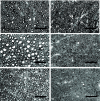Ex vivo evaluation of ADC values within spinal cord white matter tracts
- PMID: 15709142
- PMCID: PMC7974094
Ex vivo evaluation of ADC values within spinal cord white matter tracts
Abstract
Background and purpose: Our purpose was to evaluate the effect of fixative on apparent diffusion coefficient (ADC) values and anisotropy within spinal cord white matter. As glutaraldehyde (GL) better preserves axonal ultrastructure as compared with paraformaldehyde (PF), we hypothesize that spinal cord white matter fixed with GL will have increased anisotropic water diffusion as compared with specimens fixed with PF.
Methods: Eleven rats were perfusion-fixed with either 4% PF or a combination of 2.5% GL and 4% PF. Diffusion-weighted imaging of the ex vivo spinal cord was performed using a 9.4T magnet with b values up to 3100 s/mm(2). In-plane resolution was 39 mum x 39 mum, and section thickness was 500 mum.
Results: Overall, animals fixed with a combination of GL and PF (GL-PF) showed a greater increase in longitudinal ADC (lADC) as compared to those fixed with PF only, without differences in transverse ADC (tADC). As a consequence of the increased lADC, overall anisotropic diffusion increased in those animals fixed with GL-PF, as measured with an anisotropy index (AI = tADC/lADC). Evaluation of specific tracts demonstrated that lADC for animals fixed with GL-PF were significantly elevated in the rubrospinal, vestibulospinal, and reticulospinal tracts as compared with animals fixed with PF only.
Conclusion: Using a fixative of GL-PL results in increased anisotropy (decreased AI values) in spinal cord white matter tracts, as compared with PF fixation only, largely owing to increases in the lADC values. This finding may be due to better fixation of intra-axonal cytoskeletal proteins that results when GL is combined with PF and sheds further light on underlying sources of anisotropic water diffusion in CNS white matter.
Figures


References
-
- Schwartz ED, Shumsky JS, Wehrli S, Tessler A, Murray M, Hackney DB. Ex vivo MR determined apparent diffusion coefficients correlate with motor recovery mediated by intraspinal transplants of fibroblasts genetically modified to express BDNF. Exp Neurol 2003;182:49–63 - PubMed
-
- Schwartz ED, Chin CL, Takahashi M, Hwang SN, Hackney DB. Diffusion-weighted imaging of the spinal cord. Neuroimaging Clin N Am 2002;12:125–146 - PubMed
-
- Schwartz ED, Hackney DB. Diffusion-weighted MRI and the evaluation of spinal cord axonal integrity following injury and treatment. Exp Neurol 2003;184:570–589 - PubMed
-
- Nevo U, Hauben E, Yoles E, et al. Diffusion anisotropy MRI for quantitative assessment of recovery in injured rat spinal cord. Magn Reson Med 2001;45:1–9 - PubMed
-
- Ford JC, Hackney DB, Alsop DC, et al. MRIcharacterization of diffusion coefficients in a rat spinal cord injury model. Magn Reson Med 1994;31:488–494 - PubMed
Publication types
MeSH terms
Grants and funding
LinkOut - more resources
Full Text Sources
Research Materials
